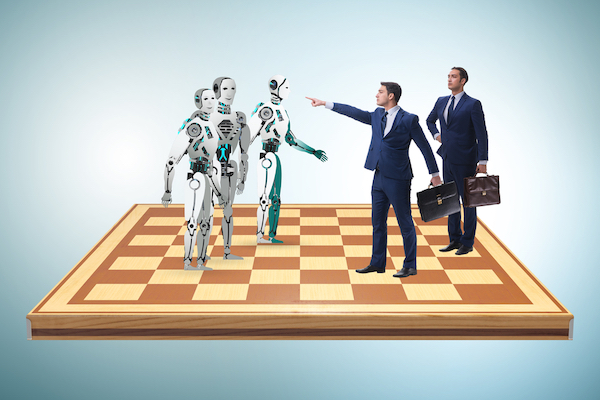“Companies should update their invention disclosure protocols to encompass inquiries about the utilization of AI in the inventive process.”
 As artificial intelligence (AI) systems become increasingly sophisticated and play a greater role in our society, questions surrounding patentability and inventorship have come to the forefront of intellectual property discourse. This is particularly so in the wake of Thaler v. Vidal, 43 F. 4th 1207, 1213 (Fed. Cir. 2022), cert denied, 143 S. Ct. 1783 (2023), in which the Federal Circuit held that “only a natural person can be an inventor, so AI cannot be.” The U.S. Patent and Trademark Office (USPTO) recently issued guidance aimed at addressing these concerns.
As artificial intelligence (AI) systems become increasingly sophisticated and play a greater role in our society, questions surrounding patentability and inventorship have come to the forefront of intellectual property discourse. This is particularly so in the wake of Thaler v. Vidal, 43 F. 4th 1207, 1213 (Fed. Cir. 2022), cert denied, 143 S. Ct. 1783 (2023), in which the Federal Circuit held that “only a natural person can be an inventor, so AI cannot be.” The U.S. Patent and Trademark Office (USPTO) recently issued guidance aimed at addressing these concerns.
The USPTO’s guidance, published in the Federal Register on February 13, 2024, clarifies that while an AI system itself cannot be designated as an inventor under current U.S. patent law, an invention developed with the assistance of an AI system may still be deemed patentable, provided that a human made a “significant contribution” to the invention. This distinction underscores the view that AI should be perceived as a tool and, as with any other tool, its use “does not preclude a natural person(s) from qualifying as an inventor (or joint inventors) if the natural person(s) significantly contributed to the claimed invention.” Emphasizing the requirement for human involvement, the USPTO made clear that each claim of the patent or patent application must reflect significant human contribution, cautioning that any claim in which at least one human did not significantly contribute would be invalid.
Open Questions
While this significant contribution requirement is not new – any person who makes a significant contribution to at least one claim can be properly named as a joint inventor of an invention – the USPTO recognized the unique challenges posed by AI-assisted inventions, issuing a non-exhaustive list of guiding principles to assist in determining the extent of a human’s contribution in the context of AI-assisted inventions. For example, the guiding principles specify that merely recognizing a problem and presenting it to an AI system may not be enough to establish inventorship, whereas constructing a prompt in view of a specific problem to elicit a particular solution from the AI system could be. However, this raises further questions, particularly regarding the level of specificity and complexity required in formulating such prompts to be more than the mere presentation of a problem.
Time to Update Practices
The USPTO also underscores the obligation of candor and good faith incumbent upon all parties involved in patent filings, extending this duty to disclosing instances where AI substantially contributed to an invention without significant human involvement. Although AI systems cannot legally be named as an inventor, practitioners will need to have a comprehensive understanding of the AI’s role in the creation of an invention, as well as the specific human involvement, so that the claims can be effectively drafted around the human contributions. In practice, companies should update their invention disclosure protocols to encompass inquiries about the utilization of AI in the inventive process. Additionally, practitioners are advised to inquire about the origin, development and training processes of the AI system. In an ideal world, detailed records of all the AI’s inputs and outputs, as well as the models and datasets used in its training and evaluation, would be saved in case they are needed later to serve as crucial evidence of human involvement in the invention process.
The Guidance Will Evolve
With its ability to generate novel solutions, optimize processes, and even mimic human creativity, AI stands out as a transformative force, reshaping industries and challenging traditional legal frameworks. The USPTO recognizes that the guidance concerning AI-assisted inventions is an iterative process, with inventorship and determining the significance of a human contribution to an invention representing areas ripe for further clarity and refinement.
Image Source: Deposit Photos
Author: Elnur_
Image ID: 433448038

![[IPWatchdog Logo]](https://ipwatchdog.com/wp-content/themes/IPWatchdog%20-%202023/assets/images/temp/logo-small@2x.png)


![[Advertisement]](https://ipwatchdog.com/wp-content/uploads/2024/04/UnitedLex-May-2-2024-sidebar-700x500-1.jpg)
![[Advertisement]](https://ipwatchdog.com/wp-content/uploads/2024/04/Artificial-Intelligence-2024-REPLAY-sidebar-700x500-corrected.jpg)
![[Advertisement]](https://ipwatchdog.com/wp-content/uploads/2024/04/Patent-Litigation-Masters-2024-sidebar-700x500-1.jpg)

![[Advertisement]](https://ipwatchdog.com/wp-content/uploads/2021/12/WEBINAR-336-x-280-px.png)
![[Advertisement]](https://ipwatchdog.com/wp-content/uploads/2021/12/2021-Patent-Practice-on-Demand-recorded-Feb-2021-336-x-280.jpg)
![[Advertisement]](https://ipwatchdog.com/wp-content/uploads/2021/12/Ad-4-The-Invent-Patent-System™.png)






Join the Discussion
4 comments so far. Add my comment.
Anon
February 27, 2024 09:21 amfrancis,
Nothing in my comment leads one to think that I have a position that training sets are not crucial.
Human involvement in training sets though does not – and cannot rise to the level of those human actions meriting the legal distinction of being inventors of anything related to output. It is NOT “training sets” that would be claimed as any invention. The article is NOT sufficient (anthropomorphication only gets you so far, and like the photograph in the Simian Selfie case, there IS an artifact to which NO HUMAN properly rises to the level of satisfying the legal definition of being the inventor of the artifact.
You have not avoided the Hobson choice. There is no Kirk answer to the Kobayashi Maru.
Try again.
francis hagel
February 26, 2024 09:04 am@Anon
You may disagree with my assertion that training datasets are crucial. But let me point out that this is the opinion of respected AI experts such as that of Ron Schmelzer, Managing Partner and Principal Analyst at AI Focused Research and Advisory firm Cognilytica., laid out in his article « The Achilles’ Heel Of AI” https://www.forbes.com/sites/cognitiveworld/2019/03/07/the-achilles-heel-of-ai/#273c53927be7 (in which the Achilles’ Heel of AI refer to the training datasets).
The introduction is telling :
« Garbage in is garbage out. There’s no saying more true in computer science, and especially is the case with artificial intelligence. Machine learning algorithms are very dependent on accurate, clean, and well-labeled training data to learn from so that they can produce accurate results. If you train your machine learning models with garbage, it’s no surprise you’ll get garbage results. It’s for this reason that the vast majority of the time spent during AI projects are during the data collection, cleaning, preparation, and labeling phases. According to a recent report from AI research and advisory firm Cognilytica, over 80% of the time spent in AI projects are spent dealing with and wrangling data. »
The article provides very detailed and helpful information about the tasks involved in the preparation of training data, clearly stressing the required human contributions.
As to the inventorship issues in AI cases, the AIPPI resolution Q272 of October 2020 lists human inventive contributions at every stage of AI in points 4(a)-(e).
Points 4(c ) and 4(d) of the resolution relate to training datasets :
4.c. A natural person who selects data or a data source for training an AI algorithm should be considered to be an inventor or a co-inventor of an invention made using that AI algorithm if the data or data source are selected with the purpose of solving a predetermined problem which is effectively solved by the invention.
4.d. A natural person who selects or generates data or selects a data source for input to a trained AI algorithm should be considered to be an inventor or a co-inventor of an invention made using that AI algorithm if the data or data source are generated or selected with the purpose of solving a predetermined problem and the invention effectively solves the problem.
The resolution is available at https://aippi.soutron.net/Portal/Default/en-GB/RecordView/Index/3832. It was adopted by the 40+ national groups of AIPPI, including the US group which is a division of AIPLA.
As to the question of whether IA can be regarded as capable of generating autonomous creation, as implied in some parts of the posted article, or only as tools used by persons, a very detailed and insightful analysis is provided in « Clarifying Assumptions About Artificial Intelligence Before Revolutionising Patent Law » by Kim et al, GRUR International, 71(4), 2022, 295-321 https://doi.org/10.1093/grurint/ikab174.
It is shown in this article that the term « artificial intelligence » reflects an incorrect anthropomorphic perception of AI leading some to believe in IA’s ability to generate creations without human actions.
Anon
February 23, 2024 09:34 amfrancis,
I see an even bigger impact that is (perhaps not so oddly) related to your concern of enabling disclosure.
As you are likely aware, patent documents are legal documents and not engineering documents.
The level then of necessary disclosure MUST be viewed as only that which is necessary to avoid UNDUE experimentation by those who may be deemed to have the capabilities of Person Having Ordinary Skill In The Art.
As such, I disagree with your assertion that training datasets are crucial, as PHOSTIA will recognize that training data sets are a necessary item, and the particulars of such are within the skills of PHOSTIA to determine without UNDUE experimentation. Such is NOT viewed as an invitation to research, as claims are often distinguishable from any such research OF THE training set.
I have a different conundrum for you (and the larger community): the Hobson’s choice of whether or not AI (and perhaps more specifically, Generative AI), can invent or not.
If one chooses the view that AI cannot invent, that it is merely “use of a machine,” then ALL output must be viewed as no more than highlighting what already exists. This of course is one huge can of worms as to the US meaning of prior art, which is to recognize State of the Art. The USPTO guidance then portends a DOOM of any applicant statement of what an AI provided will be – and must be – treated as Applicant Admitted Prior Art. This leads directly to the same DOOM as the other side of the Hobson Choice.
The other side of the Hobson Choice is the view that AI can invent. To such a conclusion then, the USPTO guidance – specifically focusing on the aspect of humans must provide Significantly More – means that any actual valid claims will be constrained TO that explicit ‘significantly more,’ and reliance on any portion of AI will create the DOOM of AI being a joint inventor, making any such claim unenforceable.
Given that one Major Pharma Executive went on record last year in one of the Government AI public discussions that their advances ARE from use of AI, we have an immediate problem.
francis hagel
February 23, 2024 05:12 amI agree with your recommendations to practitioners to inquire about the origin, development and training processes of the AI system.
What I find surprising in the USPTO AI guidance is its exclusive focus on inventorship issues and lack of concern about an enabling disclosure. For an invention related to the use of an AI system for a certain purpose, the key components of the system must be adequately disclosed. This includes in particular the training datasets which is so crucial for the operation of an AI system.
It is of note that this is mentioned in the 2024 revision of the EPO Guidelines F-III-3 :
“Occasionally applications are filed in which there is a fundamental insufficiency in the invention in the sense that it cannot be carried out by a person skilled in the art […] another example can be found in the field of artificial intelligence if the mathematical methods and the training datasets are disclosed in insufficient detail to reproduce the technical effect over the whole range claimed. Such a lack of detail may result in a disclosure that is more like an invitation to a research programme”.
Add Comment